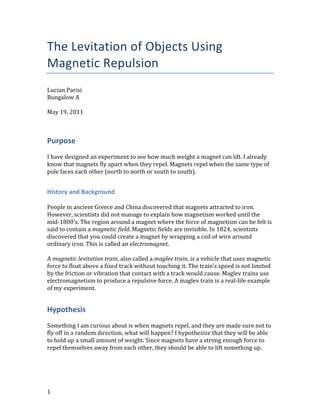
The Levitation of Objects Using Magnetic Repulsion
- 1. The Levitation of Objects Using Magnetic Repulsion Lucian Parisi Bungalow A May 19, 2011 Purpose I have designed an experiment to see how much weight a magnet can lift. I already know that magnets fly apart when they repel. Magnets repel when the same type of pole faces each other (north to north or south to south). History and Background People in ancient Greece and China discovered that magnets attracted to iron. However, scientists did not manage to explain how magnetism worked until the mid-‐1800’s. The region around a magnet where the force of magnetism can be felt is said to contain a magnetic field. Magnetic fields are invisible. In 1824, scientists discovered that you could create a magnet by wrapping a coil of wire around ordinary iron. This is called an electromagnet. A magnetic levitation train, also called a maglev train, is a vehicle that uses magnetic force to float above a fixed track without touching it. The train’s speed is not limited by the friction or vibration that contact with a track would cause. Maglev trains use electromagnetism to produce a repulsive force. A maglev train is a real-‐life example of my experiment. Hypothesis Something I am curious about is when magnets repel, and they are made sure not to fly off in a random direction, what will happen? I hypothesize that they will be able to hold up a small amount of weight. Since magnets have a strong enough force to repel themselves away from each other, they should be able to lift something up. 1
- 2. Experiment Design This experiment requires magnets to be placed so that their same poles face each other, making them repel and lift an object. To keep the magnets from flying off in a random direction, I use a clear plastic tube and circular magnets. That way, when the magnets repel they will levitate, and if the hypothesis is accepted, they will also lift the object. The constants in this experiment are: The tube material The size of the tube The type of magnet The type of object to be levitated The procedure used The manipulated variable used is the number of magnets on top and bottom. The responding variable is the weight lifted. To measure the weight lifted, I will put penny rolls into to the tube until the two groups of repelling magnets are forced to touch. Using a kitchen scale, I weigh one of the penny rolls and multiply the weight of a single roll times the number of rolls held up. Materials Number Item 1 36 in. clear plastic tube (1 in. diameter) 18 Circular magnets (1 in. diameter) 15 Penny rolls 1 Kitchen scale 1 Magazine (to put under tube) 2
- 3. Procedure 1. Using the kitchen scale, weigh one penny roll and record the result. 2. Place the plastic tube in front of you. 3. Get six magnets and split into two equal groups of 3 each. 4. Place the magnets into the tube, making sure they repel. 5. Drop penny rolls inside the tube until the magnets are forced to touch. 6. Record how many penny rolls it took to force the magnets to touch. 7. Do steps 3-‐6 again, using 6 magnets on top and bottom, 9 magnets on top and bottom, and 12 magnets on top and bottom. Measurements and Results The following table and graph show my measurements. Number of Penny Rolls (Weight) Magnets Lifted 6 9 (42 ¾ oz.) 12 11 (52 ¼ oz.) 18 13 (61 ¾ oz.) 24 15 (71 ¼ oz.) Weight (oz.) Results 80 70 60 50 40 Weight (oz.) 30 20 10 0 Number of 6 12 18 24 magnets 3
- 4. Conclusion My hypothesis was accepted. Magnetic force is very strong – stronger than I expected. I was expecting that six magnets could only hold up one penny roll. However, they held up many more. I conclude that magnetic repulsion can levitate objects. For future experiments, I could try using the same experiment design to make a projectile and see how far it will go. Or I could try the original experiment with larger objects and more magnets. 4
